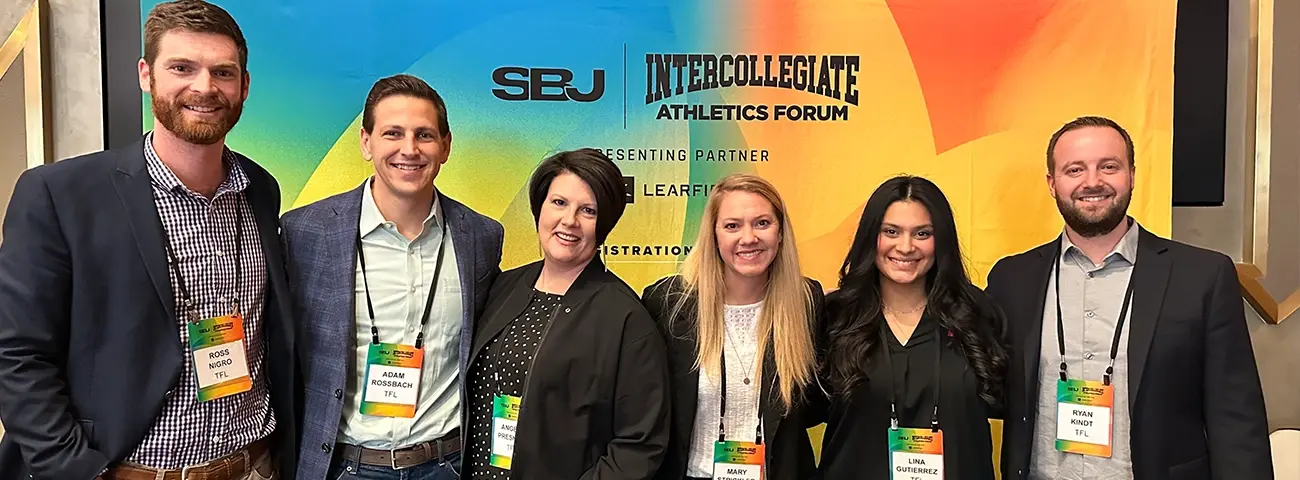The NIL Revolution Discussed at SBJ’s Intercollegiate Athletics Forum
At the beginning of December, TFL attended and participated in Sports Business Journal’s Intercollegiate Athletics Forum in Las Vegas. The conference highlighted key topics in the collegiate space including discussions around student athlete mental health, sports betting and other industry issues.
Among the popular topics was NIL – a major challenge that started before Charlie Baker assumed his role as president of the NCAA on March 1, 2023, but a priority ever since.
“I started talking about NIL shortly after I got the job because it was the only thing I heard about between the time my appointment was announced in December and the time I showed up in March,” he said at SBJ’s conference.
Name, image and likeness – which refers to student athletes being able to make money based on their identity – went into effect in 2021. At the beginning, states, schools, collectives and athletes had to navigate unchartered territory without much guidance from the governing body.
While there have been some guidelines offered since the NIL era began, new rules and regulations are at the forefront of NIL discussions as it continues to develop. With layers in the NIL landscape, it isn’t the only focus for schools.
SBJ’s conference, which was held in Las Vegas at the beginning of December, featured a panel called “N.I.L Challenges; Opportunities and Where We See It Going.”
Moderated by Bill Carter, NIL consulting and education at Student-Athlete Insights, the panel included four athletic directors: Ross Bjork of Texas A&M University, Greg Byrne of the University of Alabama, Pat Chun of Washington State University and Heather Lyke of the University of Pittsburgh.
One of the focuses of the panel discussed the correlation between NIL and the transfer portal – another recent addition to the NCAA. While the transfer portal opened in 2018, rules changed in 2021 that allow student athletes to transfer once without having to sit out a year.
“We can’t ignore the fact that NIL is used in the recruiting world,” said Lyke. “It’s certainly not an unintended consequence.”
In a previous survey by Carter, 67% of student athletes who were already considering transferring said that NIL would play a role in their decision including whether to transfer and to what school.
Lyke added that with inflation and a lack of transparency, “nobody knows what’s real,” as an NIL deal can be worth more one day than the next and/or someone can make up a fabricated deal to help in their negotiations.
“Obviously, you couple that with the transfer portal concept… That’s sort of the unattractive aspect to NIL and recruiting, is that if they lure them into the portal or we offer something, they’ll go into the portal, and it’s based on recruiting. It’s used as a recruiting tool.”
And because recruiting is such an important aspect of college athletics, there has been some concern that donors who previously directed their money to athletic departments for other reasons would divert the funds to NIL deals.
“You have real economic pressures to where you still have to find resources within your budget… to keep this thing operating at a level that it takes,” said Byrne. “I think there are real pressure points because you want to continue to expand your donor base, your fanbase… but there are limits to it across the board.”
Byrne suggested he hasn’t seen a “huge drop off,” but there have been people trying to make decisions on what they do support.
In several NIL discussions, the concern of a lack of consistency in rules came up.
Bjork referenced communication with collectives: “we need to educate them on what the rules are. We need to make sure there’s transparency. The athletes have to turn in [their NIL] contracts to our compliance office. That’s part of our university policy but also the Texas law.”
Texas’ law is not consistent with other states.
“That’s part of the problem,” Chun said in response to Bjork. “Fifty different states, 30 different state laws. We don’t have a state law so our relationship with a collective is going to be very different than the state of Texas, state of Alabama and state of Pennsylvania.”
The many layers to NIL have not been figured out yet, but it does seem that we’ll see more regulations coming soon.
“I believe by the end of the year, we’re going to have policies in place, voted on by the [Division 1] board and the Board of Governors around consumer protections for the student athletes around NIL,” Baker added.
The NCAA and its schools, athletes and collectives are maneuvering through a college sports environment they’ve never seen before, and even as more regulations come into effect, there’s a major opportunity for students and colleges to capitalize on the growing landscape of NIL.



